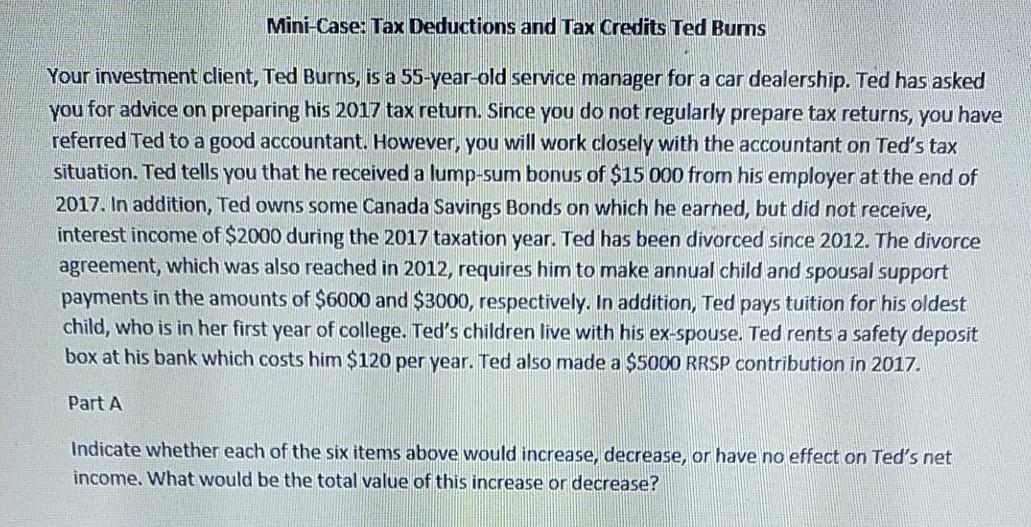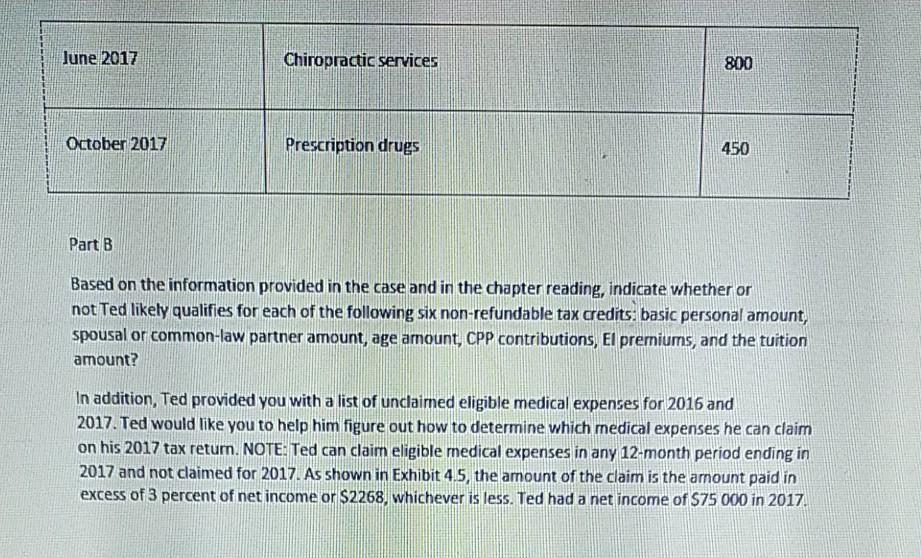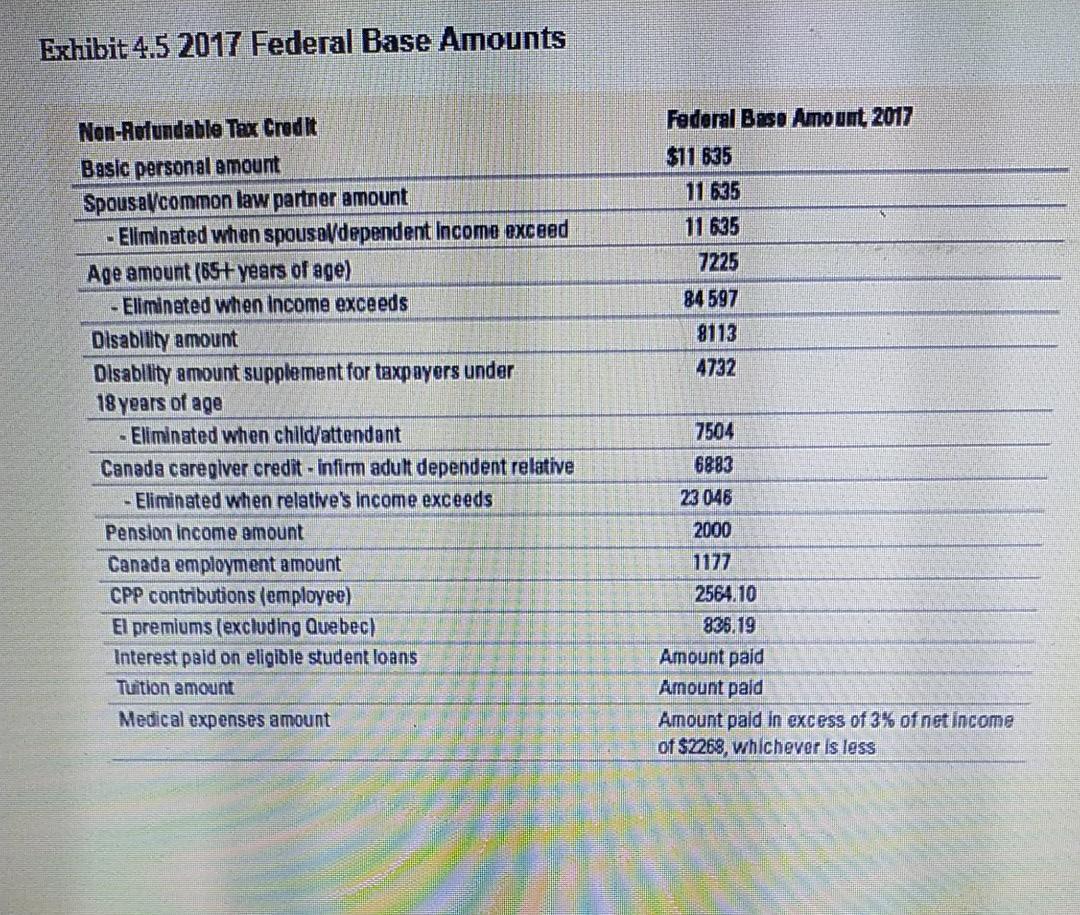Answered step by step
Verified Expert Solution
Question
1 Approved Answer
Mini-Case: Tax Deductions and Tax Credits Ted Burns Your investment client, Ted Burns, is a 55-year-old service manager for a car dealership. Ted has




Mini-Case: Tax Deductions and Tax Credits Ted Burns Your investment client, Ted Burns, is a 55-year-old service manager for a car dealership. Ted has asked you for advice on preparing his 2017 tax return. Since you do not regularly prepare tax returns, you have referred Ted to a good accountant. However, you will work closely with the accountant on Ted's tax situation. Ted tells you that he received a lump-sum bonus of $15 000 from his employer at the end of 2017. In addition, Ted owns some Canada Savings Bonds on which he earned, but did not receive, interest income of $2000 during the 2017 taxation year. Ted has been divorced since 2012. The divorce agreement, which was also reached in 2012, requires him to make annual child and spousal support payments in the amounts of $6000 and $3000, respectively. In addition, Ted pays tuition for his oldest child, who is in her first year of college. Ted's children live with his ex-spouse. Ted rents a safety deposit box at his bank which costs him $120 per year. Ted also made a $5000 RRSP contribution in 2017. Part A Indicate whether each of the six items above would increase, decrease, or have no effect on Ted's net income. What would be the total value of this increase or decrease? Date Item February 2016 Laser eye surgery (one eye) Amount $1600 March 2016 Dental services (cleaning & x-rays) 250 July 2016 Dental services (fillings) August 2016 Hearing aid January 2017 Prescription drugs 1200 750 175 March 2017 Laser eye surgery (one eye) 1600 April 2017 Out-of-country medical services 1400 June 2017 Chiropractic services 800 October 2017 Prescription drugs Part B 450 Based on the information provided in the case and in the chapter reading, indicate whether or not Ted likely qualifies for each of the following six non-refundable tax credits: basic personal amount, spousal or common-law partner amount, age amount, CPP contributions, El premiums, and the tuition amount? In addition, Ted provided you with a list of unclaimed eligible medical expenses for 2016 and 2017. Ted would like you to help him figure out how to determine which medical expenses he can claim on his 2017 tax return. NOTE: Ted can claim eligible medical expenses in any 12-month period ending in 2017 and not claimed for 2017. As shown in Exhibit 4.5, the amount of the claim is the amount paid in excess of 3 percent of net income or $2268, whichever is less. Ted had a net income of $75 000 in 2017. Exhibit 4.5 2017 Federal Base Amounts Non-Refundable Tax Credit Basic personal amount Spousal/common law partner amount -Eliminated when spousal/dependent Income exceed Age amount (65+ years of age) - Eliminated when income exceeds Disability amount Disability amount supplement for taxpayers under 18 years of age - Eliminated when child/attendant Canada caregiver credit - infirm adult dependent relative - Eliminated when relative's income exceeds Pension income amount Canada employment amount CPP contributions (employee) El premiums (excluding Quebec) Interest paid on eligible student loans Tuition amount Medical expenses amount Federal Base Amount 2017 $11 635 11 635 11 635 7225 84 597 8113 4732 7504 6883 23 046 2000 1177 2564.10 836.19 Amount paid Amount paid Amount paid in excess of 3% of net income of $2268, whichever is less
Step by Step Solution
★★★★★
3.44 Rating (147 Votes )
There are 3 Steps involved in it
Step: 1
To determine whether each item would increase decrease or have no effect on Teds net income we need to understand the tax implications of each item Heres an analysis of the six items and their impact ...
Get Instant Access to Expert-Tailored Solutions
See step-by-step solutions with expert insights and AI powered tools for academic success
Step: 2

Step: 3

Ace Your Homework with AI
Get the answers you need in no time with our AI-driven, step-by-step assistance
Get Started


